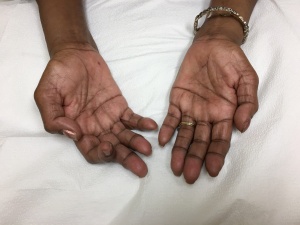Simian hand
The simian hand deformity can occur with severe median neuropathy, combined median and ulnar nerve lesions, lower brachial plexopathy, C8 radiculopathy, motor neuron disease or severe peripheral polyneuropathy, in this case due to long-standing CIDP. When the disease process also involves ulnar innervated muscles, there is severe atrophy of the entire hand and the fingers lie with the MCP joints slightly extended and the IP joints slightly flexed (claw hand deformity). The term clawing refers to the position of the fingers, the term simian hand refers to the position of the thumb.
References
1. Brazis PW, Masdey JC, Biller J. Localization in clinical neurology, 7th ed. Philadelphia: Wolters Kluwer, 2017. 2. Campbell WW. DeJong's The neurologic examination.7th ed. Philadelphia: Wolters Kluwer Health/Lippincott Williams & Wilkins, 2013.
